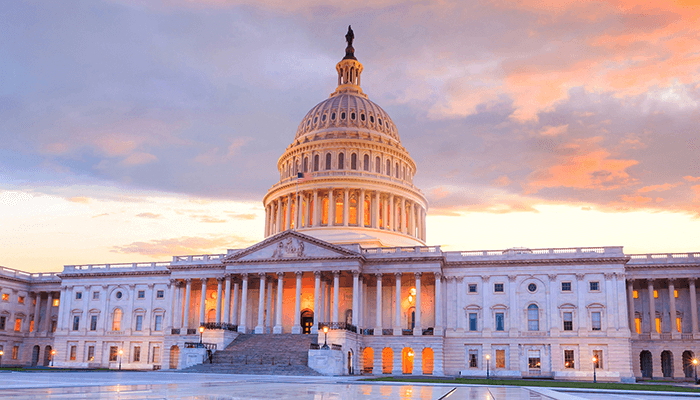Fiscal Goals Become Very Difficult with Reconciliation Plans
It would take more than $7 trillion of ten-year savings to stabilize debt at the size of the economy by Fiscal Year (FY) 2034. But rather than making progress toward reaching this or other fiscal goals, Congress is working to make those goals much more difficult – by potentially $11.5 trillion over a decade.
In this piece, we show that:
- Stabilizing debt at the size of the economy by 2034 would require roughly 50 percent more savings under the House-adopted budget resolution’s allowable debt increase, two-thirds more under a currency policy baseline, or over two-and-a-half times more under the entirety of President Trump’s tax cut agenda.
- Achieving a deficit of 3 percent of GDP by 2034 would require roughly 50 percent more savings under a current policy baseline or more than double the savings under the entirety of President Trump’s tax cut agenda.
- Balancing the budget – likely already out of reach under current law at $15 trillion of ten-year savings – would require additional savings of nearly $4 trillion under current policy or nearly $10 trillion under President Trump’s tax cut agenda.
The House budget would allow lawmakers to increase primary deficits by $2.8 trillion over a decade, which we estimate would increase debt by $3.4 trillion by 2034. Implementing a current policy baseline would have even greater costs; one version of current policy based on a CBO analysis would increase primary deficits by $3.9 trillion. And pursuing President Trump’s reported tax priorities – including no taxes on overtime, Social Security, or tip income as well as increases to the State and Local Tax deduction cap and tax cuts for domestic production – could increase primary deficits by about $10 trillion through 2034.
However, we already face a grim and worsening fiscal situation, with deficits projected to total more than $21 trillion from 2025 through 2034 under current law and debt on track to reach 117 percent of Gross Domestic Product (GDP) by 2034. While it would require $7.2 trillion of ten-year savings to reduce debt to 100 percent of GDP under current law, the House budget would raise that to $10.6 trillion, a current policy baseline would raise it to $11.7 trillion, and enacting all of the President’s tax priorities would raise it to $18.7 trillion.
Savings Needed to Meet Various Fiscal Goals, FY 2025-2034
| Fiscal Goal | Current Law | House Budget' | Current Policy# | Trump Tax Priorities |
|---|---|---|---|---|
| Debt Targets | ||||
| 110 percent of GDP | $3.0 trillion | $6.4 trillion | $7.5 trillion | $14.5 trillion |
| 100 percent of GDP | $7.2 trillion | $10.6 trillion | $11.7 trillion | $18.7 trillion |
| 98 percent of GDP (current level) | $8.1 trillion | $11.4 trillion | $12.5 trillion | $19.6 trillion |
| 90 percent of GDP | $11.5 trillion | $14.8 trillion | $15.9 trillion | $23.0 trillion |
| 80 percent of GDP | $15.7 trillion | $19.1 trillion | $20.2 trillion | $27.2 trillion |
| Deficit Targets* | ||||
| 4 percent of GDP | $5.3 trillion | N/M | $9.1 trillion | $14.9 trillion |
| 3 percent of GDP | $7.8 trillion | N/M | $11.6 trillion | $17.4 trillion |
| Primary Balance^ | $6.4 trillion | N/M | $10.0 trillion | $15.5 trillion |
| Full Budget Balance^ | $15.2 trillion | N/M | $19.0 trillion | $24.8 trillion |
Sources: Congressional Budget Office and Committee for a Responsible Federal Budget.
Notes: Figures include interest. ‘House Budget deficit figures are not meaningful because complying with its instructions would require several policy expirations in 2033 to abide by the Senate Byrd rule. #Current policy assumes extension of TCJA provisions as described in a recent letter by CBO. ^Balance figures are adjusted to exclude the effects of timing shifts. *Assumes modified savings path of the CRFB Fiscal Blueprint for Reducing Debt and Inflation.
The more aggressive fiscal goals would be even more difficult to reach. The President and his advisors have frequently mentioned the goal of balancing the budget, including in the President’s address to a joint session of Congress in early March. Assuming the enactment of his entire agenda, that would likely be completely out of reach – under current law, $15.2 trillion of ten-year savings is already aggressive, but $24.8 trillion is likely impossible.
Importantly, the House budget's reconciliation instructions would very likely require several policy expirations in 2033 in order to abide by the Senate's Byrd rule prohibition against reconciliation legislation increasing long-term deficits. This renders deficit target estimates in 2034 as not meaningfully different than current law and thus we do not estimate them.
In a forthcoming analysis, we will outline the difficulty of achieving these goals with spending cuts alone and exempting large parts of the budget, such as Social Security and Medicare, from cuts.
The magnitude of the above changes highlights the difficulty we already face in getting our fiscal situation on a sustainable path. Lawmakers should reflect on these figures and use reconciliation for its intended purpose – to decrease deficits.

